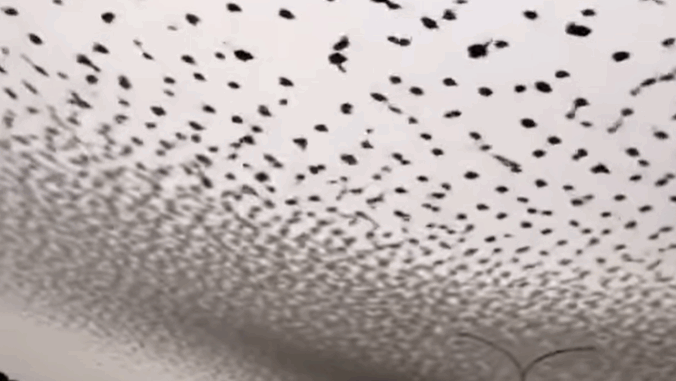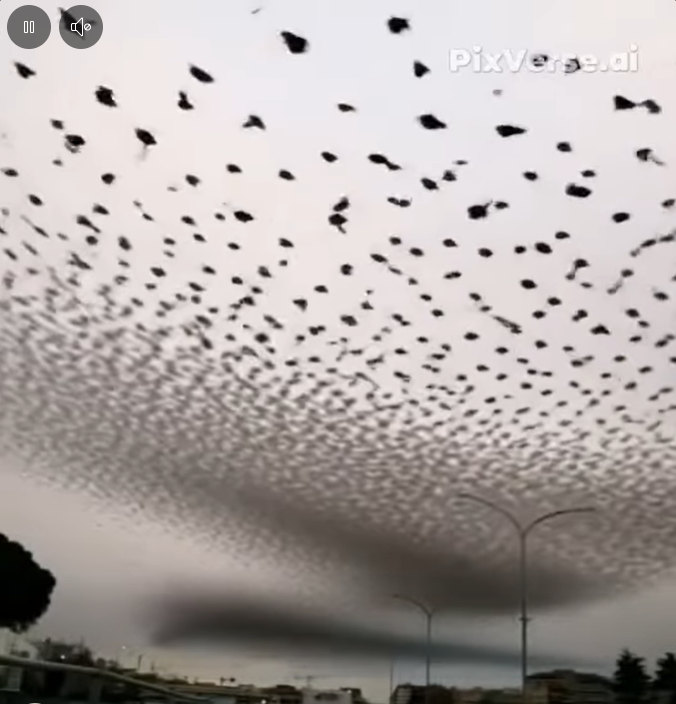

“Watch the Skies Over Rome”: Are the Starlings Trying to Tell Us Something?
It began with a cryptic warning from famed psychic Mhoni Vidente—just one hour ago:
“Eyes to the sky. Rome is speaking.”
To most, it sounded like a poetic aside. But for some in Italy’s capital, it felt more like a prophecy. Because what’s happening above Rome tonight isn’t normal.
Residents have grown used to winter’s aerial ballet—the dazzling murmurations of thousands of starlings swirling above piazzas and rooftops. But this year, something’s off.
Birds are flying lower than usual. Their movements are frantic, not fluid.
Locals say the flocks seem agitated—darting in jagged, chaotic paths, screaming at the skies long after sundown. Some have even described a low-frequency hum accompanying their movement—something not easily captured on video, but deeply felt by those beneath it.
Is it just a seasonal shift, or the start of something stranger?
The Beauty—and Curse—of Rome’s Winter Visitors
Each year, as temperatures plummet across northern Europe, waves of starlings arrive in Rome, drawn by its warmth and ample food. By twilight, the skies morph into a living canvas, painted with their mesmerizing patterns.
To tourists, it’s a dream. To Romans, it’s often a nightmare.
What isn’t captured on postcards is the mess they leave behind. Bird droppings coat streets, cars, monuments—even passersby. Sidewalks become slick. Statues get streaked. Commuters carry umbrellas under perfectly clear skies. And despite decades of countermeasures—ultrasonic devices, predator calls, and laser deterrents—nothing has broken the cycle.
This year, however, it isn’t just the mess that has people talking. It’s the energy.
Strange Signs and Sudden Questions
Several Roman neighborhoods have reported unusual power flickers in sync with large murmurations. Dogs have been howling without cause. And in Trastevere, residents swear they heard something—not quite a bird call—echoing through alleyways late at night.
City officials have chalked it up to coincidence. But social media is alive with speculation.
“This isn’t just a bird thing,” one user wrote. “It’s like they’re warning us. Or fleeing from something we can’t see.”
And then there’s the psychic’s warning: vague, yes. But unsettlingly timed.
A City Suspended Between Myth and Science
Rome has always been a place where history, faith, and the unexplained collide. From ancient omens to modern-day prophecies, its citizens have long looked to the skies for meaning.
Are these birds just nature in motion—or a messenger no one understands?
For now, the murmurations continue, painting the sky with mystery. And Rome, ever eternal, watches and wonders.
✅ Final Thought
The starling swarms over Rome remain one of nature’s most captivating sights—beautiful, haunting, and increasingly strange.
Whether this year’s odd behavior signals a natural shift, a subtle warning, or something more supernatural is still unclear. But one thing is certain: the skies over Rome have stories to tell. And this winter, we’d be wise to listen.
10 Clear Signs He May Not Be the Right Partner for You

Oral cancer, a leading type of head-and-neck cancer, is emerging as a serious health challenge in India. Recent statistics indicate nearly 77,000 new cases and over 52,000 deaths in the country this year alone. While the disease primarily affects men over 40, younger individuals are not immune. A combination of lifestyle choices and environmental factors plays a significant role in its development.
Tobacco use—including smoking and chewing—is the leading cause of oral cancer. In many regions, smokeless tobacco products are widely available and socially accepted, making prevention more difficult. Alcohol consumption further increases the risk. When combined with tobacco, the likelihood of developing oral cancer rises sharply, especially with long-term use.
Betel-nut chewing, a traditional practice in several Indian communities, also contributes to the risk. Betel nut contains carcinogenic compounds that can damage the mouth’s lining, potentially leading to cancerous changes. Sun exposure is another factor, particularly for those who work outdoors. Farmers, construction workers, and street vendors face a higher risk of lip cancer due to prolonged sunlight exposure.
Early detection is vital for effective treatment, yet many cases in India are diagnosed at advanced stages. Low awareness, limited access to healthcare, and hesitation to seek medical advice for early symptoms such as persistent mouth sores or ulcers contribute to late diagnoses. Addressing this growing health concern requires comprehensive public health initiatives. Education campaigns, regular screenings, and efforts to reduce tobacco, alcohol, and betel-nut use are essential steps toward preventing oral cancer and improving outcomes for those affected.
Để lại một phản hồi